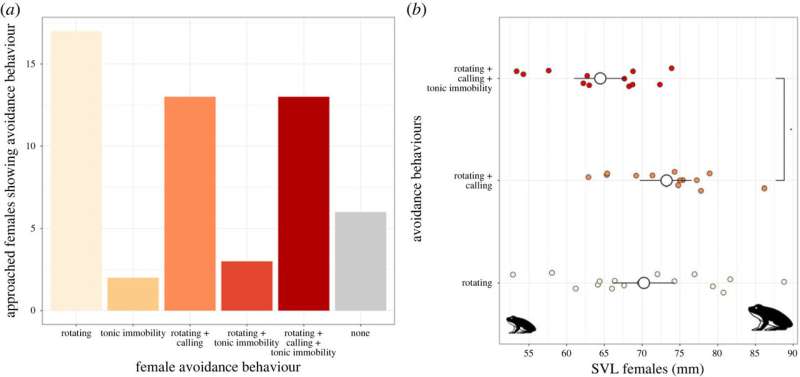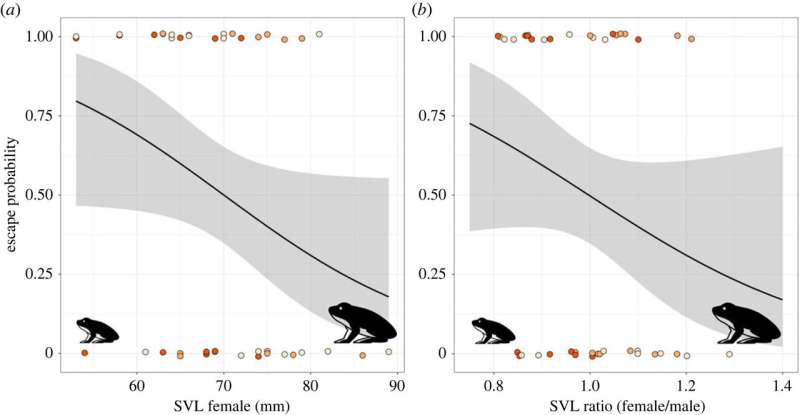October 21, 2023 feature
This article has been reviewed according to Science X's editorial process and policies. Editors have highlighted the following attributes while ensuring the content's credibility:
fact-checked
peer-reviewed publication
trusted source
proofread
New study with video shows how female frogs defend themselves against unwanted mating

Among many species, breeding preferences and tactics can differ among males and females. When aggressive behavior by males toward unreceptive females goes awry, it may result in failure to reproduce, and in some cases, fatality for the females involved. This may be particularly true among species of explosive breeders in anurans, an order including some 4,500 species of frogs and toads, in which a higher risk of mortality has been reported for mating females.
Explosive breeding species—which include the European common frog, Rana temporaria—have a short and concentrated reproductive season, which is marked by intense competition among males. In contrast, prolonged breeders reproduce over longer periods, with males typically establishing separate territories—which they defend against other males—and using mating calls to attract females.
In R. temporaria, previous findings have been mixed on whether unreceptive females are able to fend off unwanted male advances. Such advances can include harassment, intimidation, and forced copulation (amplexus) by one or more males at once. At least one recent study on this topic indicates that females lack the means to guard against this aggression and characterizes their reproductive behavior as passive, but older research describes it to the contrary.
Now, researchers from the University of Jyväskylä in Finland and Germany's Leibniz Institute for Evolution and Biodiversity Science and Berlin–Brandenburg Institute of Advanced Biodiversity Research have investigated female mate avoidance tactics among R. temporaria in a new study, titled "Drop dead! Female mate avoidance in an explosively breeding frog." Their work is published in Royal Society Open Science.
During their earlier study on mate choice among breeding R. temporaria males, the researchers used video to record the frogs' mating behavior. Their descriptions and quantifications of the female avoidance tactics they observed led to this new work.
The researchers found that unreceptive females used three mating avoidance tactics:
- Rotating, in which the female attempts to rotate around her own body axis as a male with the goal of amplexus uses his hind feet to try to stop her;
- Release calls, described as grunts and squeaks emitted by females during amplexus; and
- Tonic immobility (feigning of death), in which a female stiffens with her arms and legs outstretched after amplexus by a male.
The researchers observed all three behaviors by frogs in water, and they note that in one case, a female exhibited tonic immobility during a mating attempt on land.

Among 54 amplexed females, 83% of them exhibited rotation by itself or in combination with one or both of the other tactics. About half (48%) of the amplexed females emitted release calls, always in combination with rotating. One-third (33%) of all clasped females displayed tonic immobility, combining it with rotating and calling in 13 of 18 cases.
Notably, smaller females used all three tactics, while larger females tended to use rotating combined with calling. A total of 25 of the amplexed females (46%) displaying these tactics managed to escape. Smaller females showed a higher probability of escape.
The researchers posit reasons for the popularity of rotating as a female tactic of mating avoidance, including:
- Female survival (forcing the male underwater via rotation could force him to release the female in order to avoid drowning himself);
- Testing of males' endurance and strength, possibly to expand a female's mating season survival chances through a stronger male's physical elimination of rivals attempting to amplect her at the same time.

The researchers also suggest that mechanical grip characteristics may explain why smaller female frogs more easily escaped amplexus by rotating than did larger ones: A much larger male might simply not be able to hold a smaller female tight enough to maintain the activity.
Meanwhile, tonic immobility, which occurs in species throughout the animal kingdom, may be related to stress. Earlier research shows that higher levels of corticosterone in the blood due to stress may interfere with breeding activity and may lead to longer periods of tonic immobility.
Because the researchers observed that smaller females exhibited all three behaviors more frequently than did larger ones, they suggest that females' age or experience might also be a factor driving this behavior.
They also note the frequency of multiple amplecting males forming "mating balls" with a single female as another possible stressor that drives tonic immobility; this condition can lead to death for both males and females by drowning.
The larger question of why the female frogs might choose or reject specific males as mates is still unknown.
The research states, "It remains to be determined which (phenotypic or genotypic) trait(s) is (are) under selection, leading to mate acceptance or rejection, and what benefits and costs, if any, are associated with mate choice by female R. temporaria. There seem to be no obvious direct benefits of choosing a particular male, as males provide no parental care or defend any resources.
"Direct benefits, such as increased fertilization success by larger or size-assorted males have been disproved; in fact, fertilization success has been found to be independent of size assortment."
Nevertheless, it is clear that mating is not a simple process in R. temporaria, and that females do not always remain passive when it occurs. Future studies, the researchers suggest, could focus on comparing females' stress corticosterone levels to age and sex ratios, as well as how age ratios, sex ratios, and varying frog densities affect mate selection and the risks of reproduction.
More information: Carolin Dittrich et al, Drop dead! Female mate avoidance in an explosively breeding frog, Royal Society Open Science (2023). DOI: 10.1098/rsos.230742
Journal information: Royal Society Open Science
© 2023 Science X Network




















